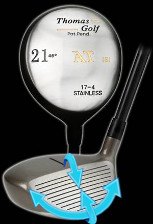
“Bulge and roll” is a term used in golf to describe the design features of the clubface on a driver or a fairway wood. It refers to the curvature or contours on the face of these clubs, which are intentionally designed to enhance performance and improve the golfer's ability to hit straighter and longer shots.
Here's a breakdown of the two components:
- Bulge: The bulge refers to the curvature of the face from heel to toe. The face is slightly convex, meaning it curves outward in the center. The bulge is typically more pronounced on drivers than on fairway woods. The purpose of the bulge is to counteract the natural side spin that occurs when the ball is hit off-center on the face. When the ball impacts the bulged face, it tends to correct the spin and promote straighter shots.
- Roll: The roll, also known as the gear effect, refers to the curvature of the face from top to bottom. The face is slightly concave, curving inward from the center towards the top and bottom. The roll is more pronounced on drivers than on fairway woods. The roll helps to correct the spin and trajectory of the ball when it is struck above or below the center of the clubface. If the ball is hit high on the face, the roll helps to reduce backspin, while if it is hit low on the face, the roll helps to add loft and increase spin.
The combination of bulge and roll on the clubface aims to improve the forgiveness of off-center hits, reduce the severity of hooks or slices, and provide more consistent ball flights. These design features allow golfers to achieve better results even when they don't strike the ball perfectly in the center of the clubface.
It's important to note that the extent of bulge and roll can vary among different club models and manufacturers. Golfers should experiment with different clubs and find the ones that suit their swing and deliver optimal performance for their game.
The faces of woods are not uniformly flat, but slightly curved. The curvature from heel to toe (horizontal) is called bulge, while top to bottom (vertical) curvature is called roll.
Bulge compensates for the golf ball spin imparted by off-center hits. For instance, a shot hit off the club’s toe will have left sidespin; bulge makes the ball start farther right than a shot hit dead-center. Conversely, a heel shot will spin right; bulge makes it start left.
Roll affects the loft of a shot depending on where the ball strikes the face. A ball hit high on the face will travel higher than a center strike, while a ball hit low on the face will fly lower.





